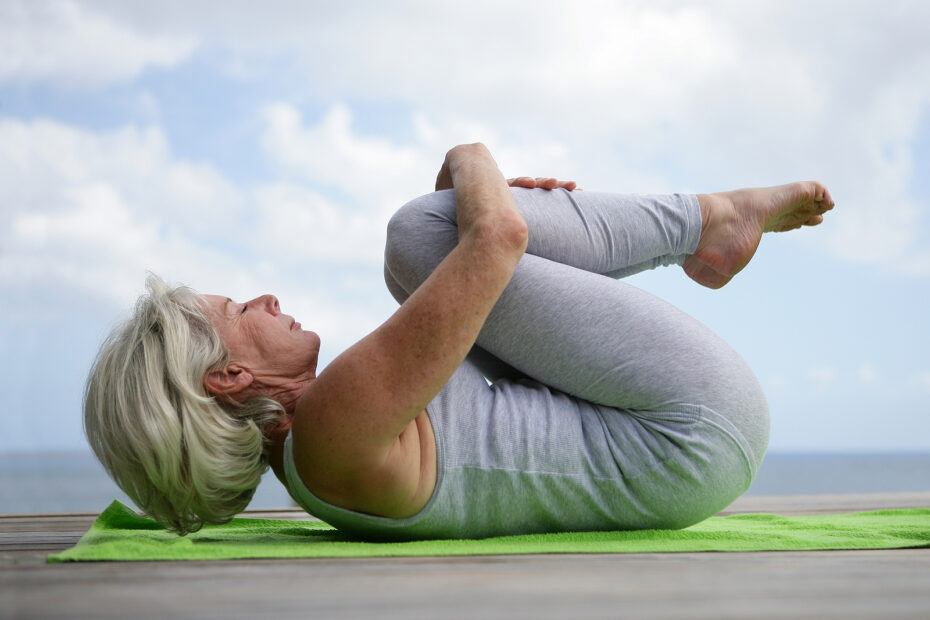Lower back pain is a common issue for many seniors, often resulting from years of wear and tear, reduced physical activity, or good ol’ fashioned tightness.
Fortunately, regular stretching can help alleviate discomfort and improve overall mobility.
The catch, of course, is knowing which stretches to do and how to do them correctly.
But don’t fret, we’re here to help.
In this article, we’ll go over some gentle lower back stretches that are particularly beneficial for seniors.
We’ll also cover some great tips to make sure you stay safe and get the most from these exercises.
First things first though…
Why Stretching Matters for Lower Back Health
Low back pain is one of the most common issues found in seniors and it’s been reported that upwards of 70% of folks over the age of 65 deal with back pain at some point or another.
That’s a lot of seniors.
Lower back pain can come from a lot of different underlying causes, but regardless of the source, most back pain can be improved with targeted stretching.
And even if you don’t have pain, you may experience low back stiffness and tightness that make it more challenging to get around the house.
As we age, our muscles and joints naturally lose some of their flexibility, making us more prone to stiffness and pain, especially in the lower back.
Stretching can help to:
- Relieve Tension: Stretching loosens tight muscles and reduces tension, which can significantly alleviate lower back pain.
- Improve Flexibility: Regular stretching enhances your range of motion, making everyday activities easier and less painful.
- Enhance Circulation: Stretching increases blood flow to the muscles, promoting faster recovery and reducing the risk of injury.
- Promote Relaxation: Gentle stretches can also help relax the body and mind, contributing to overall well-being.
In other words, stretching offers a lot of benefits.
That said, I know all too well that seniors can have a hard time finding a comfortable way to stretch and exercise.
The same tightness and pain mentioned earlier can also make it more challenging to exercise (if this stuff was easy, I’d be out of a job).
Fortunately, the exercises mentioned in this guide are very gentle and accessible for most seniors – but we still need to be aware of some important safety issues before exercising.
Safety First: Tips Before You Start
Before diving into the stretches, keep these safety tips in mind:
- Warm Up: Begin with a few minutes of light activity, like walking in place or gentle marching, to warm up and reduce your chances of straining a muscle.
- Listen to Your Body: Never push yourself into a stretch that feels painful. Stretch to a point where you feel a gentle pull, not pain.
- Breathe Deeply: Focus on deep, even breathing as you stretch, which helps to relax your muscles and improve the effectiveness of the stretch.
- Consult Your Doctor: If you have any existing back issues or other health conditions, check with your doctor before starting any new stretching routine.
7 Gentle Lower Back Stretches for Seniors
These stretches are easy to do at home and are gentle enough for most seniors to perform. They can also be adapted to your comfort level, helping you maintain a healthy lower back.
1. Double Knee to Chest
This is a nice stretch to start with because you can do it from the safety of your bed and it puts very little stress through your low back.
This stretch also puts you in the fetal position, which is usually one of the most comfortable positions to be in.
- From a lying position, gently bend both legs up so that your feet are on the bed
- From here, gently bring one leg in toward your chest at at time
- Hold both knees in toward your chest as you feel a stretch in your low back and hips
- Hold for 20-30 seconds, repeat 3-4x
2. Single Knee to Chest
This exercise is identical to the exercise mentioned above, but instead of bringing both knees in toward your chest together, you stretch one leg at a time.
Doing one leg at a time tends to target the glutes (muscles in the back of your hips) a little more, but it also makes it easier to do for seniors who have a hard time with the double knee to chest.
- From a lying position, gently bend one leg up and pull it toward your chest as tolerated
- Hold for 20-30 seconds and then rest it back on the bed
- Switch sides and repeat
- Stretch each leg 3-4x
FYI, this is a great hip stretch for seniors as well.
3. Lateral Trunk Rotations
This is one of my favorite low back stretches (for folks of all ages) because it’s low impact and stretches a little bit of everything.
It’s a great exercise to try if you can’t get comfortable or you’re feeling stiff first thing in the morning.
It’s also nice that you can do it from the comfort of bed.
- From a lying position, bend both knees up and rest your feet on the bed
- Keep your knees together and gently rotate your knees from one side to the other
- Go only as far as your back/hips will let you comfortably go
- Repeat 10-15x to each side, no need to hold
4. Seated Forward Bend
The seated forward bend is a simple stretch that targets the lower back and unlike the exercises already mentioned, it can be done from any comfortable chair.
This makes this move a nice option for reducing stiffness during the day, but if you’re prone to dizziness with head movements, be careful with this one.
- Start by sitting on the edge of a chair with your feet flat on the floor
- Slowly bend forward from your hips, reaching your hands toward your toes.
- Let your head and neck relax as you fold forward. Stop when you feel a gentle stretch in your lower back
- Hold for 10-20 seconds and slowing come back up
- Repeat 3-5x
5. Seated Cat-Cow Stretch
The traditional cat-cow stretch is a great exercise for your spinal mobility, but I know a lot of seniors struggle with getting on their hands and knees.
Fortunately, this seated version of the classic move works great too.
- Start off by sitting on the edge of a comfortable chair with your feet flat on the ground with your hands on your knees
- Gently arch your back and look up toward the ceiling
- Hold for a second and then flex your back as if you’re pulling your belly button into your spine and bringing your shoulders forward (rounding your back)
- Hold for a second and then return to the arched position, going back and forth
- Repeat 5-10x
If you’re especially talented, you can pair your breathing with the movements – inhale as you round your back, exhale as you arch your back.
6. Seated Trunk Rotation
This exercise is basically the seated version of the lateral trunk rotation mentioned earlier.
And like that exercise, this is another great move for overall spinal mobility (this exercise also does a nice job of mobilizing the thoracic spine).
- From a seated position, scoot toward the edge of the chair, while maintaining a nice upright posture
- Fold your arms in front of your chest and gently rotate your back toward one side as far as you can comfortably move
- Hold for a second and then rotate to the other side
- Repeat 5-10x for each side
As shown in the video, you can use your hands to provide a little extra pull on the chair for additional stretch, just don’t pull too hard.
7. Seated QL Stretch
“QL” stands for quadratus lumborum and it’s a deep back muscle that’s prone to getting tight and causing low back pain.
And since it’s located on the side of our low back (between our pelvis and ribs), the best way to stretch it is by bending to the side – a movement a lot of us aren’t likely doing a lot of on a daily basis.
- Start from a seated position on a comfortable chair with feet planted on the floor in front of you
- Gently bend down to one side, while trying to maintain an upright posture
- If you’re shoulders feel good, you can reach the opposite arm toward that side for an added stretch
- Hold for 20 seconds and then gently return to your starting position; repeat on the other side
- Aim for 3-4x to each side
Incorporating These Stretches Into Your Routine
To get the most out of these stretches, it’s important to do them on a regular basis.
You can do them in the morning to start your day, or in the evening to unwind and relieve any tension that has built up.
Consistency is key – regular stretching can lead to significant improvements in your lower back health and overall flexibility.
But how often should seniors do these stretches?
That’s a tough one to answer because everyone is starting from a different position and has different needs.
That said, here are a few general guidelines:
- If you’re really tight and motivated to see some improvements, aim for stretching 2x/day (1x in the morning, 1x in the evening)
- If you’re feeling stiff, but aren’t having any pain or mobility issues yet, stretching 1x/day might be a good place to start
- If daily stretching isn’t realistic, aim for at least 3-5x/week
If you’re stretching any less than 3x/week, don’t be surprised if you don’t see any noticeable results – again, stretching is all about consistency.
When to Seek Medical Advice
While stretching can be very beneficial, it’s important to know when to seek medical advice.
If you experience severe or persistent lower back pain, or if the pain radiates down your leg, consult your doctor or a physical therapist.
They can provide a tailored exercise program and ensure that you’re stretching safely.
And again – you shouldn’t experience pain while performing any of these exercises! If anything hurts, please stop and try a different position/exercise.
If you’re feeling pain (other than the normal pulling sensation that comes with stretching), you’re likely doing more harm than good.
Final Thoughts
There are a lot of great lower back stretches out there, so it wasn’t that easy for me to narrow it down for this list.
Ultimately, I included the above stretches because I feel they offer the most bang for the buck in terms of effectiveness and safety for seniors.
If you’re paying close attention, you may notice that I didn’t include any hip flexor stretches.
I agree, stretching the hip flexors is a great idea and can be extremely beneficial for achy backs, but from my experience, a lot of seniors tend to have difficulty performing these stretches without direct guidance.
So, I decided not to include any of these stretches in this guide (but that doesn’t mean they can’t be helpful).
Also, I want to mention that you shouldn’t be doing all of these stretches on the same day.
The above list offers several examples of how to stretch the same muscles in different ways, so please don’t over do it and perform all of these stretches.
I would recommend picking 3-4 of them and trying them out to see how they feel – feel free to mix and match to see what works best for you.
And when in doubt, please reach out to your local physical therapist for personalized recommendations.
Well, that about does it.
I hope you found this article helpful and if you have any questions, just leave ’em below and I’ll get back to you shortly.



